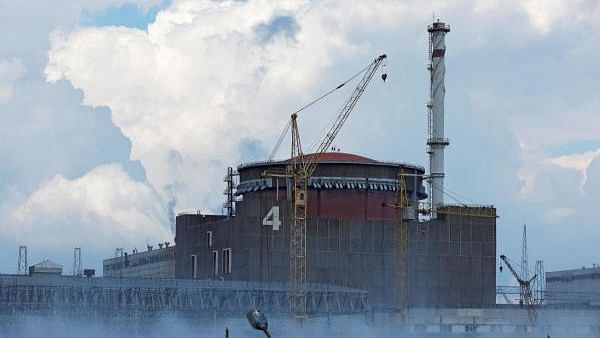
A view shows the Zaporizhzhia Nuclear Power Plant in the course of Ukraine-Russia conflict outside the Russian-controlled city of Enerhodar in the Zaporizhzhia region, Ukraine.
Credit: Reuters
By Liam Denning
Climate change is supposed to be the catalyst for the long-elusive US nuclear power renaissance, but the war in Ukraine may provide the motivation instead. Not the most inspiring comeback story, granted, but the industry will take it after this long in the wilderness.
As the first year of Russian President Vladimir Putin’s weekend war was drawing to a close, uranium was trading at about $50 per pound. However, as I noted here, talk of a US ban on imports of nuclear fuel from Russia held the potential to boost that significantly. Fast forward to May 2024 and, with fighting still raging in Ukraine, and uranium now going for more than $90, the ban is here. Come early August, imports of low-enriched uranium — the kind used in conventional nuclear plants — from Russia will be blocked by the newly enacted Prohibiting Russian Uranium Imports Act.
Uranium price.
Credit: Bloomberg
Sort of, anyway. The law authorizes the Department of Energy to issue waivers allowing imports of up to roughly a million pounds per year of Russian fuel through 2028 if it is needed to keep US reactors running. That reflects a reality not uncommon when it comes to US zero-carbon energy: dependence on foreign supplies.
Nuclear exchange.
Credit: Bloomberg
Canada and Australia won’t bother anyone in Washington, but the 12 per cent of imports from Russia do. There’s an additional 36 per cent of imports coming from Kazakhstan and Uzbekistan — so not directly under Moscow’s control but certainly in its neighborhood (as well as China’s). These figures actually understate Russia’s importance because of its outsize role in turning mined uranium into usable nuclear fuel. Russia supplies 40 per cent of the global market for low-enriched uranium, according to Citigroup Inc., and it supplied roughly a quarter of US nuclear plants’ requirements in 2022. Russia also dominates the supply of high-assay low-enriched uranium, needed by some of the advanced reactor technologies now being developed, including some small modular reactor, or SMR, designs.
Just as the US is trying to push China out of the US cleantech supply chain without derailing decarbonization altogether, it would like to get Russia out of its nuclear supply chain without risking blackouts. The waivers on imports are a means of finessing this, although Moscow could conceivably respond by imposing a ban of its own on shipments to the US. For uranium prices that have taken a breather since January, the possibilities unlocked by this new US law could fuel a renewed rally — although, as ever, speculators should beware of the overhang of inventories held by commodity funds if sentiment shifts.
For the broader project of reviving US nuclear power’s prospects, however, it could mean so much more than that. Besides starting the countdown to a (sort of) ban on Russian nuclear fuel imports, the legislation also unlocks $2.7 billion of federal funding to help develop domestic production of nuclear fuel.
The point here is less about the absolute amount of money involved and more about the intent.
For years, advocates of new nuclear plants have warned about the national security implications of allowing once-formidable US nuclear capabilities and expertise to wither as justification for a revival. They did this because the economic case for new reactors in the US remains as uncertain as it has been for decades. While the power is carbon-free, it is very expensive relative to other sources — especially when carbon remains unpriced — and carries high development risk given the years required to build plants and a propensity for budgets to be busted (see this). The vaunted answer to these issues, SMRs, have cost issues of their own.
Now that national security argument is having a moment, and one that may well be sustained given the broader shift in US policy away from globalization and toward reshoring — from “just in time” supply chains to “just in case,” as ClearView Energy Partners puts it. In the same way you would welcome cheap Chinese electric vehicles on purely economic grounds, so Russian nuclear fuel would continue to be welcomed. But that basis is giving way to strategic concerns.
If this law marks the beginning of a concerted effort to revive a US nuclear supply chain, it follows that it is intended to supply a domestic nuclear power sector envisaged to consist of more than just an existing fleet of mostly old reactors. Whether that is sensible on grounds of cost is very much debatable.
On US grids with rising penetration of intermittent renewable energy, value is migrating toward flexible dispatchable sources that can fill gaps in supply, such as natural gas peakers, batteries and also demand management. The ‘always on’ premise of nuclear plants is less suited to this, although, along with their zero emissions, they may be a good fit for the vaunted ‘always on’ datacenter electricity boom — should it transpire. Yet the high cost remains. Then again, cost is only one element among several in the debate about the future of US energy these days.